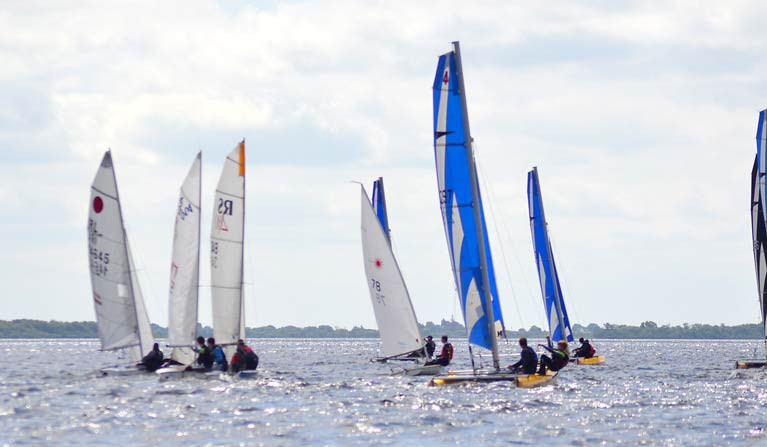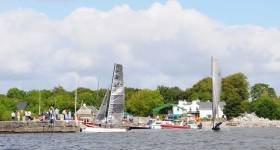Displaying items by tag: CongGalway Sailing Race
Ireland’s oldest inland sailing race will take place on August 22nd, with up to 30 sailboats taking part in the Cong-Galway Race. Ashford Castle has been announced as the 2020 race sponsor, a partnership which is made even more special through a shared connection with the famous Guinness family.
A wonderful day out for sailing enthusiasts and spectators, fans of the time-honoured boat race can line up along the Quincentennial Bridge in Galway, and watch as the racing boats are forced to capsize quickly and expertly in a bid to get their masts past the bridge’s obstruction as they near the finish line.
Sailing enthusiasts from around the country will join members from the Corrib Rowing and Yachting Club, Cumainn Seoltóireacht an Spidéil, Galway City Sailing Club and Galway Bay Sailing Club to battle it out for the title of King or Queen of Cong.
The race, which takes place over a distance of 30 nautical miles and is Europe’s longest inland race, will start in the picturesque shadow of Ashford Castle at the northern end of Lough Corrib and will follow the old steamer route from Lisloughrey pier to the city of Galway.
Traditionally taking place in June, the Cong-Galway Race will be the first competitive sailing event since the COVID-19 restrictions and interest and entry are expected to be significant.
The Prize
The winner, which will be determined based on the Portsmouth handicap scheme, will be presented with the CRYC Trophy, a treasured possession of the Corrib Rowing and Yachting Club. Both the helm and crew will also win an overnight stay on the Ashford Estate. The Helm will be awarded a one-night stay at the iconic 5-star Ashford Castle on Lough Corrib, while the crew member will receive a luxury night away at The Lodge at Ashford at Lisloughrey pier. Both prizes will be presented on the day by Ashford Estate’s General Manager, Niall Rochford.
Speaking about the sponsorship, Ashford Estate’s Niall Rochford said: “The Cong-Galway Race is steeped in history and is deeply connected to Ashford’s own story, with the castle acting as a backdrop for the race since its inception. As such, Ashford Estate’s sponsorship of this long-standing boat race is a natural fit. As a boating enthusiast myself, I am very much looking forward to presenting this year’s top team with the winning silverware and welcoming the respective winners to the beautiful Ashford Castle and The Lodge at Ashford.”
The History of The Cong-Galway Race
Ashford Castle’s long and honoured history is intrinsically linked to the age-old sailing race. The Castle was bought by Sir Benjamin Guinness in 1852, 30 years before the inaugural boat race. Sir Benjamin’s grandson, Arthur Ernest Guinness was an active member of the Royal Galway Yacht Club – the very club which co-founded the Cong-Galway Race in 1882.
The original Cong-Galway Race started at the Royal Galway Yachting Club in Galway City and travelled to Ashford Castle in Cong before returning to Galway City, a race distance of 61.5 nautical miles.
The Cong-Galway Race was a huge social event in Galway until 1914. It never recovered after the First World War and was last held in its old format in 1931. The race was later revived in 1972. Now half the original length, the race starts at Lisloughrey pier, near Ashford Castle, and ends just past the Quincentennial Bridge in Galway City.
The first boat over the finish line will be presented with this year’s prize at a reception held at Corrib Rowing and Yachting Club.
Galway Boating Clubs Unite For Historic Cong-Galway Sailing Race Across Lough Corrib This June
Sailors and boating enthusiasts from Galway’s sailing and boating clubs are coming together next month to follow their forebears in Europe’s oldest and longest inland sailing race.
On Saturday 29 June the fleet of dinghies will pit their wits against the elements and each other on the historic route along the length of Lough Corrib from Lisloughrey near Cong to Galway city.
Since 1882, sailors have raced the length of Lough Corrib. While the origin of the wager which prompted the first races is shrouded in myth and lore, the early races were hotly contested and a great social occasion.
They were very much a test of stamina as well as skill, with competitors completing a round trip of over 60 nautical miles from Galway to Ashford Castle and back again. It was raced annually until 1914 and the outbreak of World War I.
The race was revived in its current format, sailed in one direction from Lisloughrey to Galway, in 1972 and again became a stable in the Galway maritime calendar.
However, the weather gods have not been good to the race in recent years.
So, to ensure a successful event this year, the boating and sailing clubs around Galway have come together and moved the event to an earlier slot in the calendar.
It will take place this year on 29 June and follow the traditional steamer channel through the lake.
Full details of the race and the online registration are available on the Galway Bay Sailing Club website.
Transport will leave Corrib Rowing and Yacht Club and the Galway Commercial Boat Club at 8am to bring sailors to the start line in Lisloughrey. From there, the boats will make their way to Kilbeg for lunch and then continue on to the finish line in the lower Corrib.
However, the challenges don’t end there, with the Quincentennial Bridge providing a final obstacle to be negotiated — usually with the mast, sails and sailors in the water!
Following the race, there will be the chance to relive the decisive moments of the race at a reception hosted by the Commercial club after the historical silverware has been presented at CRYC.
Galway Bay Sailing Club has a link to the Notice of Race and Sailing Instructions, as well as the online registration form. For more details about the 2019 Cong-Galway Sailing Race, see the Facebook event page HERE.































































